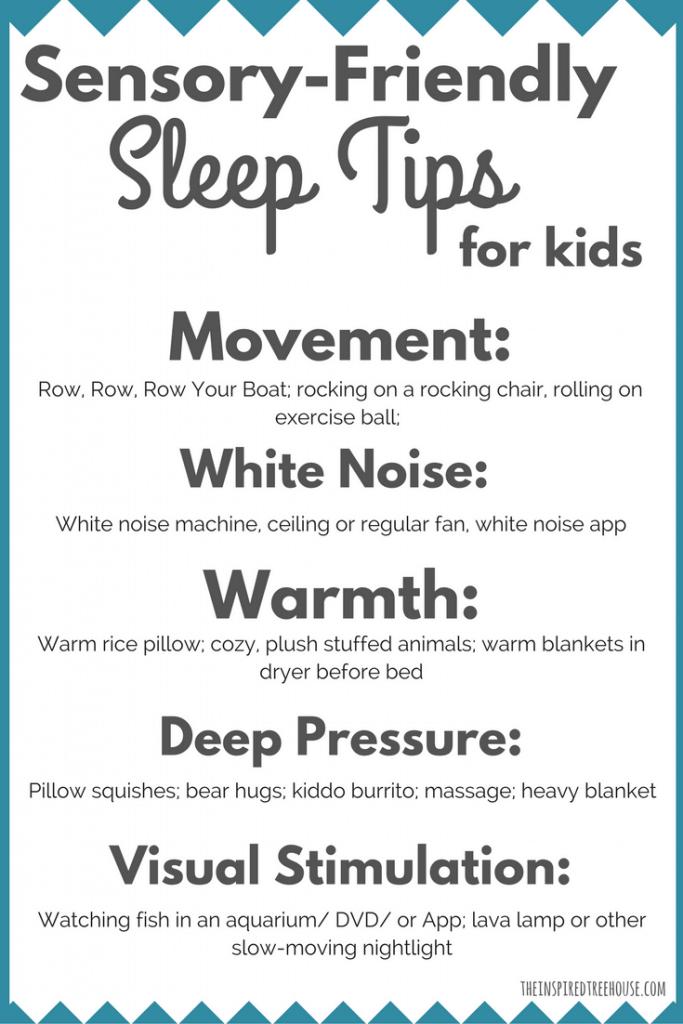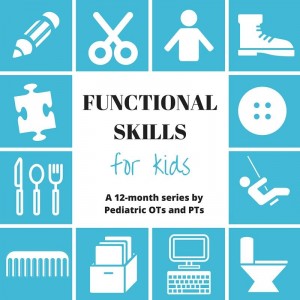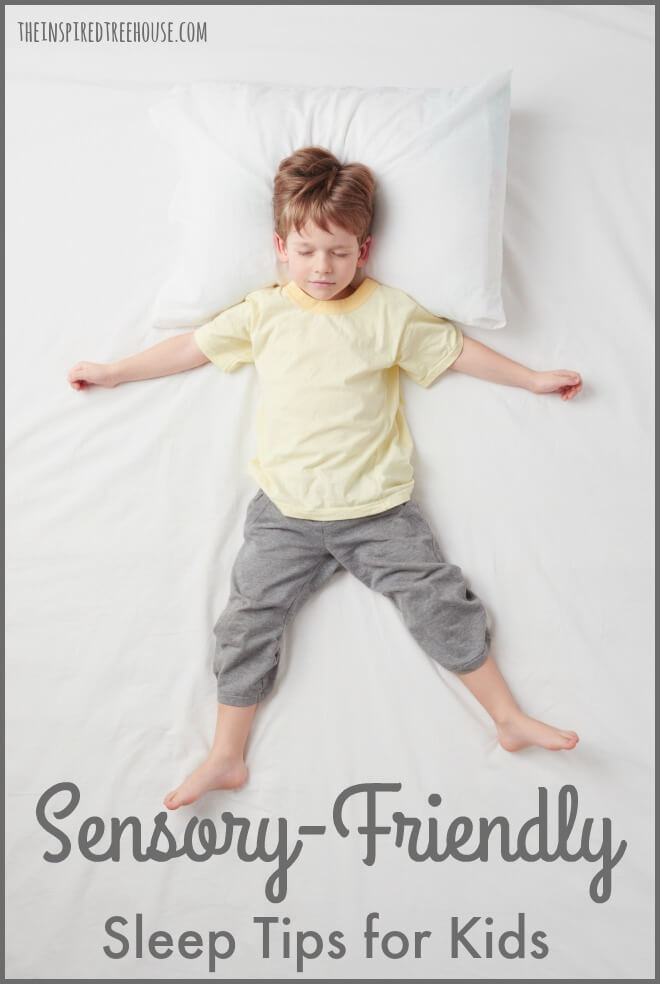For kids who have trouble sleeping, sensory techniques designed to calm and organize the body can be helpful. In fact, many of the same techniques and methods we use to calm a newborn or infant can be adapted for use with older kids to help them fall asleep more easily and hopefully stay asleep through the night.
*This post contains affiliate links. Read more here.
Today, we’re taking on sleep as part of a new year-long series with 9 other awesome Occupational Therapy and Physical Therapy bloggers about the Functional Skills of Childhood! Last month, we took a closer look at preventing tantrums using transition strategies. Be sure to check out what our other therapist friends had to say about all of the complex skills involved in kids’ school day functions!
Sensory-Friendly Tips for Kids Who Have Trouble Sleeping
Still adjusting to life outside the womb, newborn babies are very sensitive to light, sound, and movement. Their nervous systems have not yet matured enough to be able to regulate their responses to these types of stimuli and they are often not able to soothe themselves or lull themselves to sleep.
Luckily, we have a whole slew of tried and true strategies that we use to target babies’ sensory needs, helping to calm them and get them to sleep (e.g. swaddling, rocking). But many little ones continue to struggle with sleep problems into toddlerhood and beyond.
Read on to learn about some simple sensory friendly strategies that any parent can use to help calm a child at bedtime – because a well-rested kid is a happy kid!
Deep Pressure
One of the first things new parents learn at the hospital is how to swaddle their little bundle of joy because snugly wrapping a baby in a blanket provides calming tactile and proprioceptive input all over the body, making the child feel secure and safe.
What to do at bedtime:
-Use heavy blankets or quilts at night or try a weighted blanket
-Play a game of “Kiddo Burrito” before bed, rolling your kiddo up tight for a few minutes in a blanket
-Provide firm all-over pressure by hugging your little one on your lap while reading before bed
-Give firm squishes to the body with a bean bag chair or pillow
-Try a few minutes in a cocoon swing or a beanbag chair
Warmth
Show us a new mother and we’ll show you someone who has mastered the art of doing just about anything using only one hand, because babies LOVE to be held. Why? Being in someone’s arms provides tons of positive sensory benefits, including the relaxing effect of body heat.
What to do at bedtime:
-Place a warm rice pillow in bed or try a Cozy Plush microwaveable stuffed animal
-Pop blankets or comforters in the dryer for a few minutes before bed
-Zipping up inside a bedding set from Beddy’s is perfect for keeping little bodies cozy and warm!
–The Sleep Sleeve is another great way to keep little bodies cozy and warm while still offering a breathable option.’

Sound
Parents and caregivers of babies can often be heard making that familiar “shushing” noise or quietly humming to quiet and calm their little ones. These repetitive, quiet sounds mimic the calming, reassuring noises the baby heard when they were inside their mother – the sound of her heartbeat, and the sound of her muffled voice.
White noise can be calming for many children (and even adults) as they’re trying to fall asleep and it also blocks out other sounds that might startle or wake them.
What to do at bedtime:
-Place a white noise machine in the child’s room or try the Sleep Sheep, a stuffed animal with a white noise device inside
-Install a ceiling fan or place a regular fan in the child’s room
-Download a white noise app for your phone or other device

Movement
Rocking chairs and baby swings are most parents’ most prized pieces of “baby equipment” because repetitive, rhythmic rocking, swaying, and swinging provide calming vestibular input to the nervous system, helping children relax.
What to do at bedtime:
-With the child resting on his stomach on an exercise ball, slowly rock him back and forth for a few minutes before bed
-Read books in a rocking chair as part of the bedtime routine
-Try one of these Row, Row, Row Your Boat vestibular activities for kids, using a slow, steady pace
Visual Stimulation
Nearly every baby crib toy on the market has an underwater theme. Many of them come with the option to play “ocean sounds” (see the section on Sound, above) but these toys also come with the perk of soothing, repetitive visual stimulation.>
Watching flowing water, fish gliding through an aquarium, or even a crackling campfire often has a “mesmerizing effect” on kids and adults alike. Focusing on soothing visual input can help many children relax and fall asleep.
What to do at bedtime:
-Spend a few minutes watching fish glide through the water in an aquarium or try an aquarium DVD or app
-Try using a lava lamp as a night light
-Avoid cartoons, busy electronic toys that light up, and video games before bedtime

What are your best tricks for getting little ones to fall asleep at night? We’d love to hear your ideas! Leave a comment below.

This post is part of the Functional Skills for Kids series. Check out each of the posts about the development of functional skills from The Inspired Treehouse here.
Task Analysis – Independent Bathing in Children | Your Therapy Source
Tips and Tricks for Teaching Hand Washing with Kids | Growing Hands-On Kids
I can brush my teeth! Tips for Tooth Brushing and Oral Care! | Your Kids OT
Screen Free Quiet Time When Daytime Naps are History | Kids Play Space
Tips to Help Kids Learn How to Blow Their Nose | Sugar Aunts
Tips to Help Kids Who Hate Haircuts | Mama OT
Sensory Friendly Tips for Kids Who Have Trouble Sleeping | The Inspired Treehouse
Your Child With Special Needs: How to Conquer Showering Independently | Miss Jaime OT
Adolescent Hygiene Challenges | Therapy Fun Zone
Latest posts by Claire Heffron (see all)
- Pro Tips for Conquering Toddler Separation Anxiety - April 25, 2024
- Cute Zipper Bags for Therapists - April 18, 2024
- Fairy Tale Games and Toys - April 12, 2024



[…] Sensory Smart Sleep Tips for Kids […]